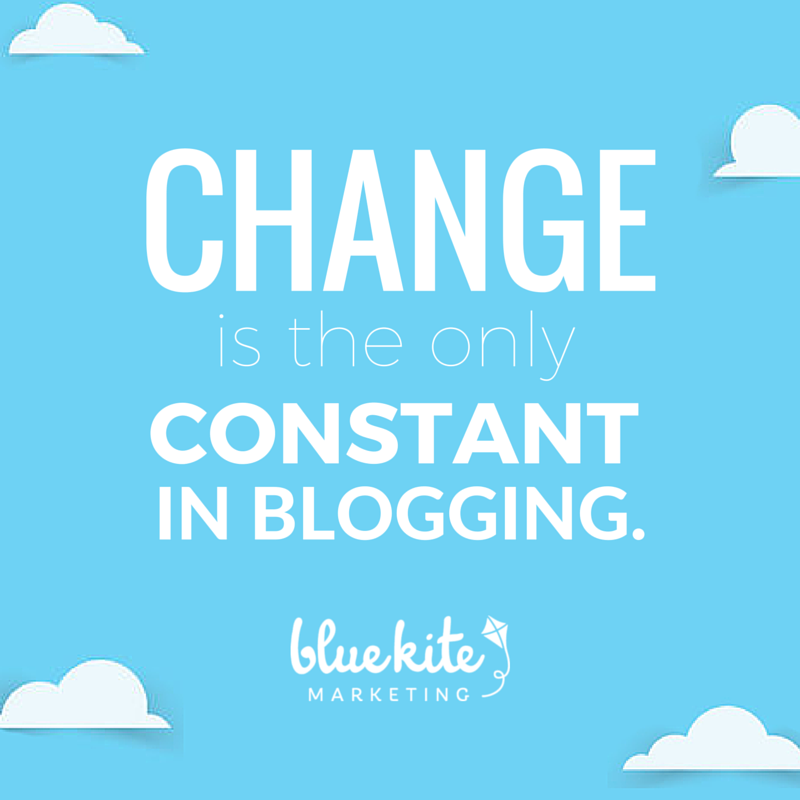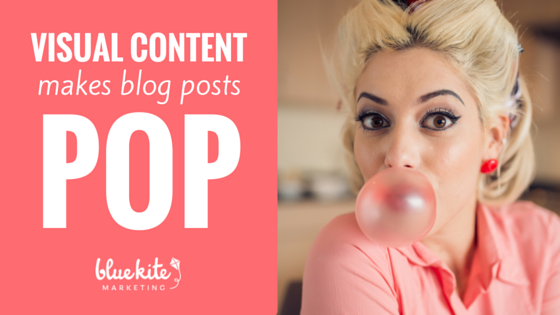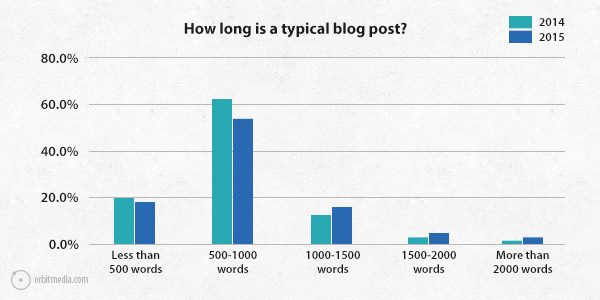Last week, marked the fifth anniversary of the Blue Kite Marketing website and blog.
And, a lot has changed since then.
Not only have I gotten better as a blogger (just check out my first post for proof), but also the blogosphere itself has changed dramatically.
The practice of blogging has grown up.
Blogging has matured into a powerful, well-respected marketing tool for businesses. And, as a result, more and more businesses are blogging today than ever before.
How Blogging Has Changed since 2010
Blogging — like digital marketing in general — is moving at a breakneck pace. Whether you’re just getting started or you’ve been blogging for business for years, it’s important to pay attention to the trends and how to adapt to this ever-changing world.

After all, the only thing constant in life (and blogging) is change.
Here’s a rundown of the biggest changes in blogging that I’ve seen in the past five years. And, I also give you some tips on how you can apply these ideas to your business blog.
1. Visual content is paramount.
To create successful blog content today, you must include prominent visuals. Several years ago, most blogs simply picked a stock photo and slapped it at the top of their post. And even then, many blogs didn’t include images at all.
But as social media has matured and audience attention spans have decreased, visual content has become more prominent. As a result, content with visuals and video perform better on social media.
Today, top performing blogs often include customized images for every piece of content. And, it’s not uncommon to find multiple types of visual content — including infographics, Slideshares, quotes and videos — peppered throughout a single blog post.
That’s why top blogs today look a lot more like a polished web magazine than a “web log” that reads like a diary.
How to Apply This Trend:
Blogging is about more than writing today. It’s important to use visuals, video and other forms of multimedia content to engage and attract readers.
Although it might seem daunting to create graphics and images for your blog posts, it doesn’t have to cost a fortune or take a ton of time. Here are a few ideas:
- Create a dynamic featured image. Use a tool like Canva or Wordswag to create an featured image that includes your headline, branding and a powerful image.
- Use screen shots. Showing readers how to do something? Or, want to offer up an example? Screenshots are a great way to do that.
- Add tweetable quotes. A great way to break up text is through a pull quote or tweet box. Click to Tweet is a simple WordPress plugin that helps you do this.
- Add GIFs. GIFs are moving images that can be embedded into your blog post. These images stand out on social networks and can make your content more interesting. See this post for an example.
2. Content promotion is more critical than ever.
Although the “build it and they will come” concept has never really worked, it was far easier to attract and build a blog audience five years ago than it is today.
As content marketing has grown in popularity, so has the sheer amount of information available to us. Standing out has become harder than ever in this noisy, information-dense world.
That’s why promoting your content is a critical component to blogging and content marketing success.
Email marketing and social media have always been powerful vehicles for content promotion, but now brands are even promoting content through social media advertising and pay-per-click campaigns.
It’s more important than ever to try new and different ways to promote your content to get in front of more readers.
How to Apply This Trend:
You don’t have to turn into a used car salesman to promote your content. Here are a few ideas:
- Use new channels. Is there a social network you haven’t tried yet? Try promoting your content there. Or, find new and different ways to spice up how you share your content on social media.
- Try paid promotion. Most social networks today offer an advertising platform. Dedicate some of your marketing budget to promoting your content through advertising to get it in front of more people.
- Personal outreach. Reaching out to friends, influencers and the media can still be a great way to get the word out about your content. Don’t ignore this tried and true approach.
For even more ideas, check out this resource — How to Promote Your Blog Posts: 45 Tips to Help You Win More Readers.
3. Blog posts are longer and more in-depth.
Despite my previous point about shorter attention spans of readers today, longer form content is on the rise.
When I started blogging, it was common practice to create short, snappy content averaging around 500 to 700 words.
But today, the typical length of a blog post is 900 words, according to Orbit Media’s recent research of top bloggers. That number is up from 100 words from last year’s survey. Had Orbit Media conducted the survey a few years ago, I’m confident that the jump in blog post length would be even bigger.
As competition for attention has become fiercer, it pays to be the go-to resource for a given topic. Longer, more in-depth content does a better job at providing the reader with valuable information and resources.
This is also why long-form content has tremendous SEO benefits — because it provides substantive answers to people’s questions.
How to Apply This Trend:
Longer content doesn’t necessary mean better content. But, it pays to find ways to make your content more substantive than your competitors. Here’s how:
- Include visuals. We already covered the importance of visuals above, but infographics, Slideshares and other visual content can help your content be more impactful to readers.
- Answer questions others miss. When researching the content of your competitors, look for things their content doesn’t include. What do they miss? Cover that in your article to stand out.
- Combine smaller topics. Instead of writing short, simple pieces of content, combine smaller topics into a larger blog post that encompasses everything someone would want to know about a particular issue. Here are some examples.
4. Conversations have moved to social.
Although there are plenty of blogs that still have large, vibrant communities, many blogs and media properties have opted to disable comments in the past year or two.
And those that still have comments available to readers, are not seeing nearly the volume they did a few years ago.
Why the change?
There are a number of reasons.
Rampant blog spam and the amount of time to manage a blog community can be chief reasons to turn comments off.
And, those with dwindling comment sections may find that conversations are happening on social media channels instead.
I know that I’ve seen that here. The volume of our comments has dropped considerably. Now, it’s more common to get comments about blog posts on LinkedIn, Facebook or Google Plus.
How to Apply this Trend:
Does this mean you should disable comments on your blog?
Not necessarily.
If you listen to our recent podcast about blog commenting, I share why I keep the blog comments open on this very blog — I want to be welcoming and allow people to comment where it suits them best.
But, even with that in mind, I have to recognize that the conversations have moved to other places. You should too.
You have to decide for yourself it if makes sense to have comments on your business blog. But either way, it’s important to monitor and respond to conversations about your business and blog — no matter where they take place.
5. Content is moving to where the people are.
There will always be a need to have a “home base” for your blog. It is absolutely essential to have a website and a blog that you own.
But as we’ve already discussed, it’s harder and harder to get noticed and attract people to your blog.
Not to mention, social media platforms want to keep you on their websites. That’s why they are making it easier for people to publish directly on their platforms.
For instance,
LinkedIn now offers the ability to publish articles within their platform.
Medium, created by Twitter’s co-founders, has become a popular publishing platform.
And Facebook is now allowing some media sites — such as The New York Times, National Geographic and BuzzFeed – to publish articles directly within their platform.
Not to mention, Facebook announced earlier this year that they are prioritizing your News Feed with “sticky content” that takes longer to read to read or consume.
That’s why more and more people are publishing their content where the people are — directly on social media platforms.
I think this is a big trend that will only grow from here. Watch for this idea to explode in the coming months and year ahead.
How to Apply This Trend:
Although I don’t suggest ditching your blog entirely, I would encourage you to test out republishing or repurposing your content for other platforms.
Here are some ideas:
- Republish. Try taking one of your blog posts and republishing it on LinkedIn, Medium or even Facebook.
- Repurpose. There are also a ton of ways you can repurpose blog content to increase your reach. Blog content can easily become graphics, presentations, Slideshares, podcasts, eBooks and more.
Blogging Will
Continue to Change
This certainly doesn’t capture all of the ways blogging has changed. Sponsored content, blog designs and
search engine optimization have all changed too. But, these were the five biggest changes I’ve spotted.
Ultimately, I think blogging has become more polished and professional as it has become a viable platform for businesses.
But, the only thing certain is that blogging will continue to change as the web — and digital marketing — continues to evolve. That’s why marketers
must
pay attention
to how blogging changes to attract the attention their business deserves.
What do you think? What are the biggest changes you’ve seen since you started blogging? How are you adapting to the latest trends?




